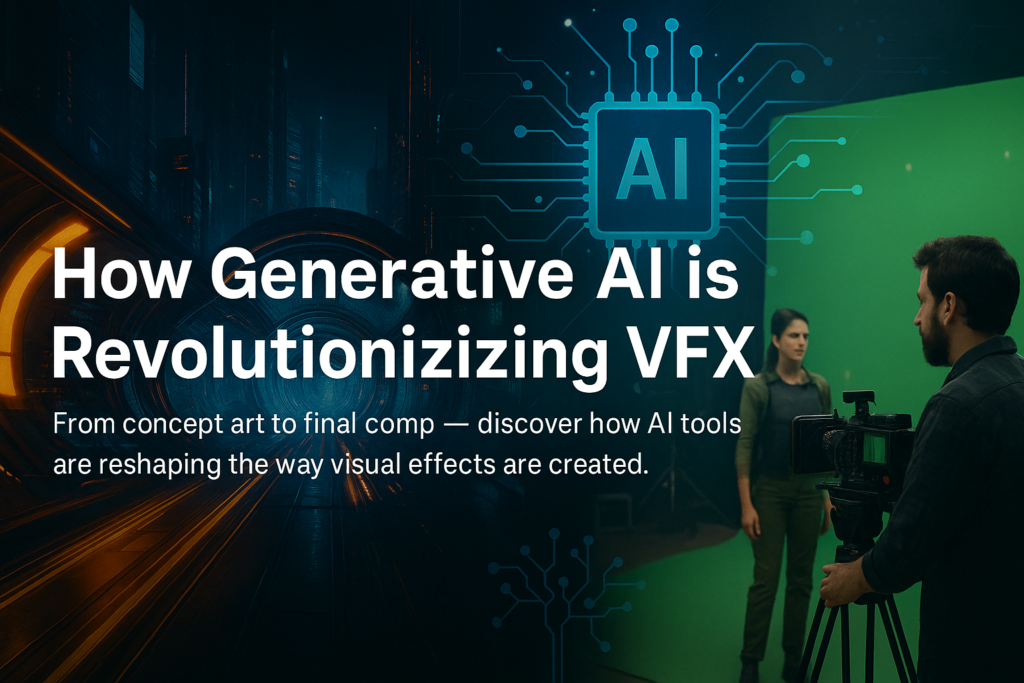The world of Visual Effects (VFX) is evolving faster than ever before. With the rapid integration of Generative AI (Artificial Intelligence), what once took weeks of manual work can now be achieved in a fraction of the time — often with surprising precision and creativity.
In this blog post, we’ll explore how generative AI is being used in VFX, the tools transforming the industry, and the implications for artists, studios, and storytellers alike.
What is Generative AI?
Generative AI refers to algorithms that can create new content — be it images, video, sound, text, or 3D models — based on the data they’ve been trained on. These systems don’t just analyze or enhance; they generate.
Examples include:
- Text-to-image tools like DALL·E, Midjourney, or Stable Diffusion.
- AI video tools like RunwayML, Pika Labs, and Sora by OpenAI.
- 3D generation tools like Kaedim, Luma AI, or Meshy.ai.
Key Applications of Generative AI in VFX
1. Previsualization (Previs) and Concept Art
AI helps directors and concept artists visualize entire scenes quickly using text prompts and sketches. Instead of hand-drawing or modeling environments from scratch, artists can:
- Generate scene thumbnails or storyboards instantly.
- Explore multiple lighting setups, mood variations, or camera angles.
- Speed up feedback cycles between concept and production teams.
2. Environment and Background Generation
Creating complex environments — from futuristic cities to alien planets — can now be assisted by AI tools that:
- Generate 2.5D matte paintings.
- Fill in gaps using AI inpainting.
- Provide texture maps or height maps for 3D workflows.
Studios use tools like Adobe Firefly, Stable Diffusion, or GAN-based models to generate high-resolution backgrounds.
3. AI-Assisted Animation & Motion Capture
Animating characters and creatures traditionally requires intensive rigging, keyframing, or motion capture. With generative AI:
- Tools like EbSynth or Krikey AI turn video references into stylized animations.
- AI mocap solutions (e.g., DeepMotion, Move.ai) let artists animate characters using simple webcam footage.
- Style transfer and pose generation tools allow fast prototyping of animated shots.
4. AI-Driven Video Editing and Compositing
In compositing, AI is used to:
- Automatically rotoscope or remove backgrounds (e.g., Runway’s rotoscoping tool).
- Generate depth maps and relight scenes.
- Upscale and restore footage with AI super-resolution and frame interpolation (e.g., Topaz Video Enhance AI).
This significantly reduces manual cleanup time in post-production.
5. Face Replacement and De-aging
Deepfake and face-swapping AI (e.g., DeepFaceLab, Roop) is now used not just for viral videos, but in real productions:
- Replacing stunt doubles with actors’ faces.
- De-aging actors for flashback scenes.
- Creating digital doubles for deceased or unavailable talent.
Marvel and Lucasfilm have already embraced AI-enhanced facial VFX in blockbuster films.
6. Generative Audio and Sound Design
VFX isn’t complete without immersive audio. Generative AI models like ElevenLabs, Boomy, or Descript help:
- Create realistic AI voiceovers.
- Synthesize foley effects or ambient soundscapes.
- Automate ADR (Automated Dialogue Replacement) for mismatched audio.
Industry Tools and Platforms Leveraging AI in VFX
| Tool/Platform | Functionality |
|---|---|
| RunwayML | Video editing, rotoscoping, text-to-video |
| Sora (OpenAI) | High-quality AI video generation |
| Kaedim | 2D to 3D mesh generation |
| Pika Labs | AI animation and short-form video |
| DeepMotion | AI motion capture from 2D video |
| Topaz Labs | Video upscaling and enhancement |
| Adobe Firefly | Text-to-image for creative workflows |
Benefits of Using Generative AI in VFX
- Faster Iterations: Rapid testing of multiple visual directions.
- Cost Efficiency: Reduces the need for expensive assets or manual tasks.
- Creative Expansion: AI can act as a creative collaborator, suggesting new ideas or styles.
- Access to Non-Experts: Entry-level artists can now achieve higher quality with AI support.
Challenges and Concerns
Despite the promise, generative AI also raises important questions:
- Copyright and Licensing: Who owns the AI-generated content?
- Ethics and Authenticity: Deepfakes and synthetic media can be misused.
- Job Displacement: Will traditional roles like rotoscope artists or concept designers become obsolete?
Most experts agree that AI should be a tool, not a replacement, empowering artists rather than replacing them.
The Future of AI in VFX
The future of VFX is undoubtedly AI-assisted. We’re moving towards a hybrid pipeline where:
- Artists set the creative direction.
- AI handles the repetitive, time-consuming tasks.
- Studios produce faster, cheaper, and more varied content for streaming, games, films, and AR/VR.
As AI matures, expect real-time generative VFX, interactive AI companions, and even fully AI-generated short films to become the norm.
Final Thoughts
Generative AI is not the end of creativity — it’s the evolution of it. For VFX professionals, embracing these tools can unlock new levels of efficiency, experimentation, and expression.
Whether you’re an artist, studio owner, or a curious enthusiast, now is the time to explore how AI can empower your VFX workflows.

